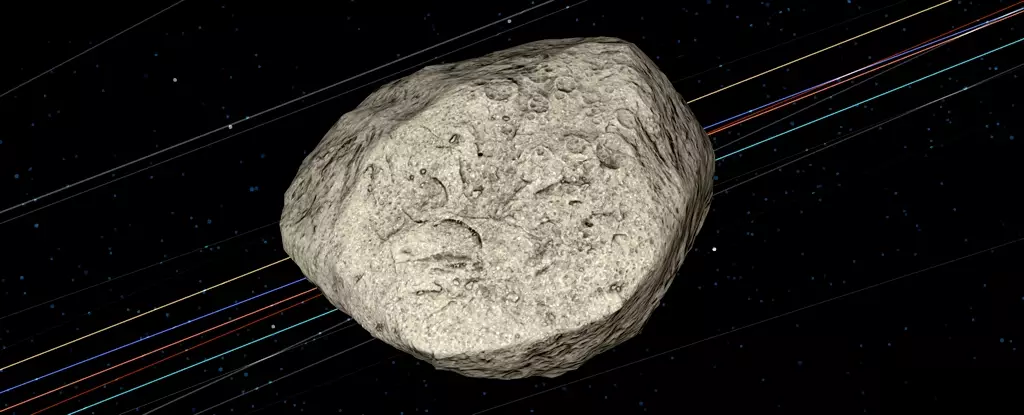Asteroid 99942 Apophis, named after the ancient Egyptian deity symbolizing chaos and darkness, is poised for a significant approach to Earth in 2029. This event is not merely an astronomical curiosity; it holds profound implications for our understanding of near-Earth objects and their interactions with planetary bodies. While this asteroid poses no immediate threat of collision with Earth, the gravitational forces at play during its close encounter could lead to substantial transformations on its surface.
First discovered in 2004, Apophis initially sent the scientific community into a frenzy as calculations suggested a potential impact. Fortunately, subsequent analyses have confirmed that Apophis will soar past our planet at a safe distance—approximately 32,000 kilometers (20,000 miles). Still, the excitement surrounding its flyby has only intensified, particularly among scientists interested in the nature of asteroids and the makeup of the solar system.
Planetary scientist Ronald Ballouz from Johns Hopkins University Applied Physics Laboratory has spearheaded research into Apophis’s upcoming 2029 flyby, specifically examining how such gravitational interactions alter an asteroid’s surface characteristics. Many near-Earth asteroids, including Apophis, exhibit a notably youthful appearance in contrast to their age, raising questions about how frequently they undergo significant changes. Most astronomical models anticipate that asteroids have surfaces that should weather slowly over billions of years; yet, nearness to Earth appears to accelerate surface rejuvenation.
Ballouz’s studies assert that the surfaces of near-Earth asteroids are generally more loose, creating a “rubbly” texture that makes them less susceptible to space weathering. This phenomenon poses an intriguing paradox—if these asteroids have existed nearly unchanged in the cosmos for billions of years, why do their surfaces appear comparatively younger than those of their more distant, stable counterparts?
By employing simulations of Apophis’s journey as it approaches Earth, Ballouz and his team hypothesized that the asteroid’s surface might experience substantial seismic activity. The gravitational pull of Earth could instigate a series of tremors or shakes as Apophis passes through our gravitational field.
Scientific models suggest that 99942 Apophis is likely to be bi-lobed in shape, evoking comparisons with the potato-shaped asteroid 25143 Itokawa. By manipulating the characteristics of a model akin to Itokawa, researchers can simulate the effects of Earth’s gravity on Apophis during its flyby. Notably, they expect detectable acceleration patterns on the asteroid’s surface, potentially altering the way its surface materials behave.
The implications of these findings are extensive. For instance, the initial seismic events generated by close proximity to Earth could lead to observable changes within Apophis that may be assessed through ground-based observatories. The subsequent, more gradual alterations in the asteroid’s rotation and surface composition could take thousands of years to manifest, but will be crucial to understanding the asteroid’s evolution.
Additionally, the flyby distance is crucial; predictions suggest that Apophis’s path will fall well within the threshold where such effects are pronounced. In fact, research indicates that an asteroid needs to pass within approximately 102,000 kilometers from Earth for its rotational state to be significantly altered—Apophis will surpass this limit, opening ample opportunities for scientific inquiry.
As 99942 Apophis prepares for this close encounter, it offers not only a unique chance to study the evolutionary dynamics of asteroids but also to engage the public’s interest in space sciences. Thanks to the favorable viewing conditions anticipated during its flyby, it could be visible to the naked eye, creating an exceptional opportunity for both academics and amateur astronomers alike.
Scientists are hopeful that this rare proximity will yield new insights into the composition of Apophis, as well as broader understandings of what influences surface characteristics in asteroids. As Earth watches Apophis make its thrilling approach, the scientific community eagerly anticipates the observations and data that will ensue, hoping for a memorable experience that enriches our knowledge of the cosmos.
While 99942 Apophis doesn’t threaten our world, its significant passage through our celestial neighborhood will undoubtedly enrich our understanding of asteroids, potential hazards, and the ever-fascinating dynamics of our solar system. The anticipation surrounding this event reflects the ongoing human pursuit to comprehend the universe and the forces that shape it.


Leave a Reply